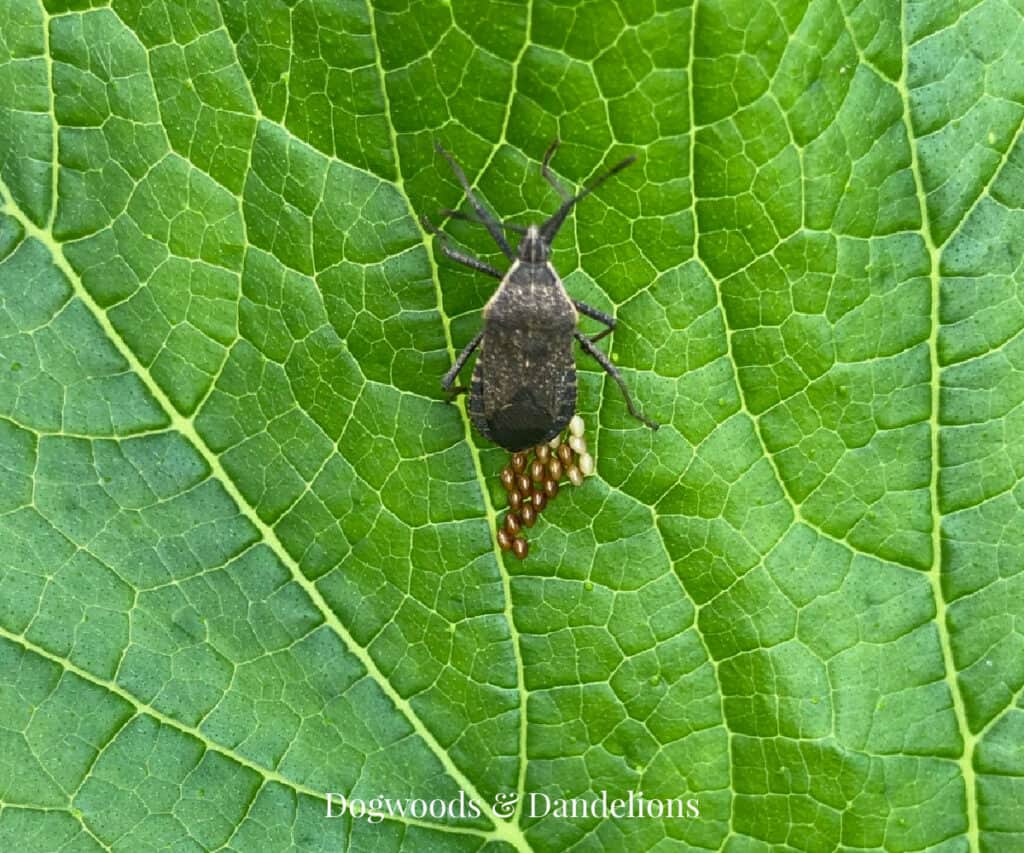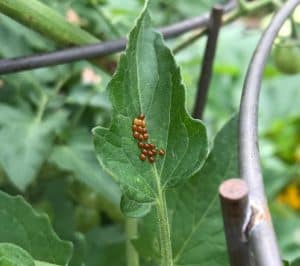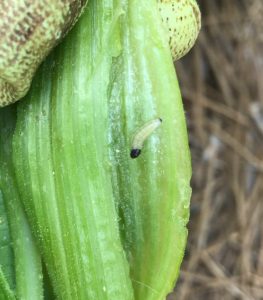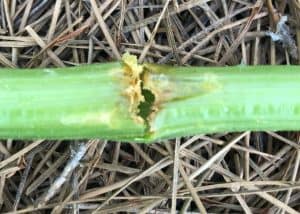Squash Bugs & Squash Vine Borers
Inside: This post shares ways to prevent squash bugs and squash vine borers from ruining your squash and zucchini.
You’ve got beautiful squash and zucchini growing in your garden. You’ve just started harvesting a few precious fruits when you notice that one plant suddenly looks wilted.
You’ve kept your garden well watered so what could it be? Your squash has likely fallen victim to the squash vine borer.
Squash bugs and squash vine borers can really ruin your squash and zucchini in a hurry. And they don’t just ruin squash and zucchini. They will infect cucumbers, pumpkins, and melons as well. Can you stop them from decimating your crop?

Affiliate Disclosure: Please note that some of the links in this article may be affiliate links and I may receive a small commission if you purchase something through a link. It will not change your cost. As an Amazon Associate, I earn from qualifying purchases. For more information, see my disclosures page.)
Squash Bugs
First, you need to know the enemy. Full-grown squash bugs are a brownish-gray color and look similar to a stink bug, only a bit longer. (See the photo above.)
They do stink when you squish them just like stink bugs do. The eggs are copper colored and are laid in neat rows, usually on the underside of the squash leaves, but sometimes on top or on the stems too.
The nymphs (young squash bugs) are a light bluish-gray color and are often found on the underside of the leaves. Many times, you will find a group of nymphs hanging out together. Squish them all!
Squash bugs feast on the sap from the plants. As they are feeding they inject a toxin into the plants that can cause them to wilt and die.
The best way to get rid of squash bugs is to check your plants daily. Squish any bugs or drop them in a container of soapy water.
Be sure to look for the nymphs too. Also, check the undersides of the leaves for the copper-colored eggs. Squish the eggs also, or you can use duct tape to remove them.
You may occasionally find squash bug eggs on other plants. I have found them on bean leaves and tomato plants, but they don’t usually do any harm to those plants.
However, the nymphs will make their way to any squash, zucchini, melons, or cucumber plants, so remove those eggs as well.
I recently discovered a way to find a lot of the squash bugs hiding on your vines. If you go out in the early morning or evening to water, water the lower stems of the vines. The squash bugs don’t like all the water and will start climbing up the stem, giving you a chance to find and squish them.


Organic Sprays to Control Squash Bugs
If the squash bug infestation is severe, there are several organic options on the market that can help. Neem oil, and diatomaceous earth are commonly recommended to get rid of squash bugs.
There is some debate about whether Neem oil is safe to use around bees. Most sources I’ve read say it must be ingested to be toxic. Since bees don’t eat plant leaves, by those standards, it is safe.
If you do use Neem oil, be sure to avoid spraying the squash flowers and try to apply it in the evening. Keep in mind, for any insecticide to kill squash bugs, you’ve got to get it on the underside of the leaves where they hang out.
And anytime you are using an insecticide, please do your own research to be sure you are comfortable using the ingredients in your garden.
Diatomaceous earth (DE) is a natural product that comes from the fossilized remains of marine plants. It is a white talc-like silica powder that works by cutting up insects and drying them out. Be sure to wear a mask when applying DE.

Squash Vine Borers
Squash Vine Borers are even more difficult to get rid of than squash bugs. Oftentimes, you will only notice the damage after it is too late.
A squash vine borer is a moth with an orange abdomen that has black dots down the center. They lay little black or copper-colored eggs on the vines of your squash and zucchini plants. The eggs are barely the size of a pencil point so you usually don’t even notice them or if you do, you think it’s just a speck of dirt.
As soon as the eggs hatch, the worm immediately bores into the plant to start feeding. The worms eat the plants from the inside so you can’t see the damage. Sometimes, the only thing you will notice is that the plant wilts during the day. This can easily be mistaken for a lack of water.



Another way to check for borers is to look and see if you have “frass” on the stems. Frass is just a fancy word for poop. The frass is usually a yellowish-brown color. (See picture above.)
If you can determine which stem the borer is in, you can gently cut the stem open and fish out the borer. You can cut him in two with scissors or a knife. Oftentimes, the plant will recover after removing the borers.
I have had the best success with this method, but you do have to be diligent. Occasionally I’ve cut open a vine only to find the borer has already moved on.
I have also accidentally broken my squash vine off doing this as well. However, the borers will eventually kill the plant so it’s a risk I’m willing to take.
Ways to Prevent Squash Bugs and Vine Borers

Wrapping the Stems? Don’t Waste Your Time
I have read that you can wrap the stems of squash and zucchini with aluminum foil to prevent squash vine borers from laying their eggs. While this is a nice thought, my squash grow way too large to keep up with this task.
And while it may reduce the numbers, I really don’t think it will prevent them. I’ve seen squash borer frass on the stem near the top of the leaf. And once they are inside the stem, they will travel all the way to the base of the plant.
Inter-Planting with Flowers
Some sources suggest that inter-planting squash and zucchini with marigolds and nasturtiums will help prevent squash bugs and squash vine borers. I planted both flowers among my squash and zucchini this year, and while it hasn’t prevented the bugs and borers, I have noticed less of them.
I definitely suggest trying this out because it’s a non-toxic way to help control the pests. The flowers also attract pollinators and make your garden pretty.
This post explains other reasons it can be beneficial to plant flowers in your vegetable garden.
Succession Planting and Row Covers
By planting and new seeds every few weeks, you can sometimes stay ahead of the squash bugs and borers. The trick to this method is to plant the seeds and then cover them with row covers.
As they grow you will need to adjust the row covers to keep the plants enclosed. Once the squash or zucchini starts to bloom, you have two options to ensure pollination.
Remove the row covers and let nature take its course or hand pollinate the vegetables.
Using row covers seems to prevent borers, but not all the squash bugs. The bugs are able to crawl under the row cover to get to the squash.
However, the borers are more likely to kill the plants, so this is definitely a good technique, especially if you check under the row covers for squash bugs.
Resistant Varieties?
I have never found a variety of squash or zucchini that is resistant to squash bugs. They seem to like them all. They also like cucumbers and melons but tend to favor the squash or zucchini.

For a squash vine borer-resistant variety try tomboncino. It is an Italian heirloom variety that can be harvested young and eaten like zucchini or they can be allowed to mature and stored to use as winter squash. (For a funny pic, check out this post of the tromboncino around my neck!)
Tromboncino don’t have a completely hollow stem like other squash so the borers have a more difficult time penetrating the vine. Keep in mind this is a resistant variety. It doesn’t mean it’s completely immune to the dreaded borers.
While I haven’t grown them myself, I have heard that acorn squash are also slightly resistant to vine borers. But since acorn squash is a winter squash, it doesn’t quite replace a summer squash.

Planting Later in the Season
I have also read that some gardeners have better luck waiting until mid-summer to plant their squash and zucchini. Supposedly, the squash bugs and borers have completed their life cycle and moved on.
My problem with this method is that I am so impatient to eat my summer veggies, I can’t wait that late to plant them. I’m more likely to try to plant them too early.
So what do you do to keep squash bugs and squash vine borers from ruining your vegetables? If you have any suggestions, I would love for you to leave a comment.
And if you want to learn more about growing squash and zucchini, check out this post.
Related Posts
- Should You Direct Sow Your Garden or Use Transplants?
- Natural Pest Control Methods for Your Backyard Garden
- The Best Vegetables for Beginning Gardeners to Grow

Meet Julie
I’m a farm girl born and bred in North Carolina. I’ve been growing a vegetable garden for over 20 years (and helping my Mom grow hers even longer). I’ve been raising chickens in my bathtub and backyard for 12+ years. I believe that homegrown food can be made simple. Let’s get started.


I have read that a peeled garlic clove at the base of the plant will repel the borer. I do not know if it works, but every year I put at least one at the base of each plant. While I get one now and then I do not seem to have a real problem, so it may be working.
That’s interesting. I had never heard of using garlic. I just might give that a try to see if it works.
You show a picture titled “squash vine borer laying eggs”. The insect is not a squash vine borer but a fly. Just thought you may want to know.
Good catch! Thank you! The post has been updated now. ?